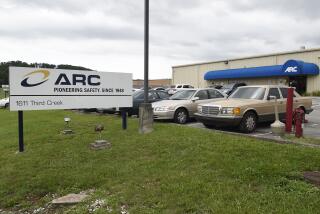Safe Car Rides . . . Without Complaints
- Share via
Five-year-old Max Kushner doesn’t want to ride in the front seat of a car anymore.
“If you explain to kids, logically, that they’re a lot safer buckled in the back, they understand,” said his mom, Dr. Pam Kushner, a Long Beach family physician and professor of family medicine at UC Irvine. Kushner is also a national spokeswoman for the Academy of Family Physicians on the subject of children and auto safety.
By now, every parent in America should have received the message from recent news reports that air bags, while effective in saving adult lives (500 just last year), can be lethal to children riding in the front seat during even a minor crash.
Maybe you’re thinking that this is not your problem because your car is an older model not equipped with passenger-side air bags. But this is one of the busiest family travel times of the year, during which many of us rent cars that have passenger-side air bags. Most rentals do.
Or we may find ourselves riding in some of the millions of dual air bag-equipped cars owned by friends and relatives. Currently, it is estimated that 24.1 million passenger cars and light trucks are dual air bag-equipped.
“The problem is when you’re in a strange automobile, you get out of your normal routine and let down your guard,” said American Automobile Assn. safety expert Michael Morrissey.
That’s particularly true during long holiday car rides on crowded highways with fidgety children who complain they’re uncomfortable in their safety seats and seat belts. I’ve been there more times than I like to remember and I know the temptation is to give in. Don’t. Instead, stop for a while to give everyone a break. Explain to the kids that it’s your responsibility to keep them safe.
The National Highway Traffic Safety Administration has proposed development of an air bag system that can detect when a child is present and deactivate itself, and there’s an industry plan to make air bags deploy with less force.
But as government and auto industry officials continue to debate how best to maximize the benefits and reduce the risks of air bags, everyone from major auto makers to physicians’ groups are banding together to instruct parents in the ABCs of safe auto travel.
Buckle everyone. Children in the back seat. “Parents want to do the right thing but sometimes they don’t know what that is,” said Janet Dewey, executive director of the recently formed Air Bag Safety Campaign.
Chrysler, Ford and General Motors are sending letters to those who own air bag-equipped vehicles reminding them of the potential risks to children and placing additional air bag warning labels in new cars.
At the same time, the American Car Rental Assn., representing most major car rental companies, along with Chicago-based air bag manufacturer Morton International, is launching a major education campaign. (For a brochure and a windshield sticker that highlights the key points of air bag safety, write ACRA ABC Program, P.O. Box 4361, Lisle, IL 60532.)
Air bags are not soft, billowy pillows. They blast out of the dashboard at up to 200 mph. The National Highway Traffic Safety Administration reports that as a result, 30 children riding in front seats have been killed. Others have been severely injured. Some were wearing safety belts. Nine infants were killed strapped in rear-facing baby seats.
“Even with all the attention, I don’t think the awareness is what it should be,” Kushner said. “No one thinks it will happen to them until it does.” The bottom line: No matter how much they bicker or beg to ride in front, keep those under 12 in the back. And never put more than one child in a seat belt.
If there isn’t enough room in the back, the National Safe Kids Campaign, a nonprofit childhood-injury prevention program, suggests:
* Put the largest child in the front passenger seat; never put an infant in a rear-facing safety seat.
* Make sure the child is properly buckled with a shoulder as well as a lap belt. Don’t allow him or her to put the shoulder belt behind or under the arms.
* Move the seat as far back from the dashboard (and air bag) as possible. The same seat position should be used by pregnant women, said Dr. Marilyn Bull, a professor at Indiana University and spokeswoman for the Academy of Pediatrics. Bell stresses that pregnant women must always fasten their seat belts. The main risk to an unborn baby is injury to her mother, and those mothers who wear safety belts sustain fewer injuries in car accidents than those who don’t, the experts say.
That’s certainly the case for children. Hedge your safety bets by making sure their belts and safety seats are buckled correctly. Too many kids aren’t properly restrained, the experts say. Don’t let them wiggle out of their shoulder belts or loosen their lap belts so they can lay down across the back seat. Invest in a booster seat for kids between 40 and 60 pounds so that the seat belt can be correctly positioned to protect them.
If the older kids complain, tell them that if all young children were properly restrained, an additional 200 lives could be saved and 20,000 injuries prevented each year. To find out more about correct safety seat and seat belt use and air bags, call the National Highway Traffic Safety Administration’s Auto Safety Hotline [800] 424-9393.
Taking the Kids appears twice monthly.






